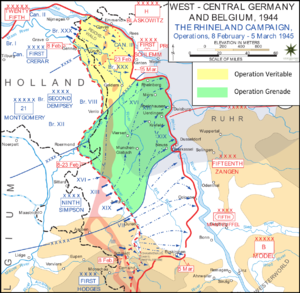
Back Schlacht im Reichswald German Operación Veritable Spanish Opération Veritable French מבצע ממשי HE Operazione Veritable Italian Маас-Рейн операциясы Kazakh Operatie Veritable Dutch Маас-Рейнская операция Russian வெரிடபிள் நடவடிக்கை Tamil ปฏิบัติการเวริเทเบิล Thai
This article needs additional citations for verification. (February 2011) |
| Operation Veritable | |||||||
|---|---|---|---|---|---|---|---|
| Part of the Western Allied invasion of Germany in the Western Front of the European theatre of World War II | |||||||
 Operations Veritable and Blockbuster (yellow) and Grenade (green) | |||||||
| |||||||
| Belligerents | |||||||
|
|
| ||||||
| Commanders and leaders | |||||||
|
|
| ||||||
| Strength | |||||||
|
200,000 men[citation needed] 1,400 guns 35,000 vehicles |
90,000 men 1,054 guns 700 mortars | ||||||
| Casualties and losses | |||||||
| 15,634 casualties[a] | ~44,239 casualties[b] (Canadian First Army Estimate) | ||||||
Operation Veritable (also known as the Battle of the Reichswald) was the northern part of an Allied pincer movement that took place between 8 February and 11 March 1945 during the final stages of the Second World War. The operation was conducted by Field Marshal Bernard Montgomery's Anglo-Canadian 21st Army Group, primarily consisting of the First Canadian Army under Lieutenant-General Harry Crerar and the British XXX Corps under Lieutenant-general Brian Horrocks.
Veritable was the northern pincer movement and started with XXX Corps advancing through the Reichswald (German: Imperial Forest) while the 3rd Canadian Infantry Division, in amphibious vehicles, cleared German positions in the flooded Rhine plain. The Allied advance proceeded more slowly than expected and at greater cost as the American southern pincer; Operation Grenade was delayed by the deliberate flooding of the Ruhr River by German forces under Alfred Schlemm, which allowed them to be concentrated against the Commonwealth advance.
On 22 February, once clear of the Reichswald, and with the towns of Kleve and Goch in their control, the offensive was renewed as Operation Blockbuster and linked up with the U.S. Ninth Army near Geldern on 4 March after the execution of Operation Grenade.[2] Fighting continued as the Germans sought to retain a bridgehead on the west bank of the Rhine at Wesel and evacuate as many men and as much equipment as possible. On 10 March the German withdrawal ended and the last bridges were destroyed.
- ^ a b Stacey, Chap 19, p. 522
- ^ "Geilenkirchen to the Rhine". A Short History of the 8th Armoured Brigade. 2000. Archived from the original on 14 February 2009. Retrieved 26 May 2009.
Cite error: There are <ref group=lower-alpha> tags or {{efn}} templates on this page, but the references will not show without a {{reflist|group=lower-alpha}} template or {{notelist}} template (see the help page).
© MMXXIII Rich X Search. We shall prevail. All rights reserved. Rich X Search